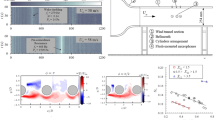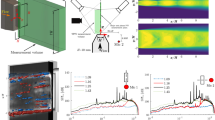Abstract
The present paper describes a method to derive information about the acoustic emission of a flow using particle image velocimetry (PIV) data. The advantage of the method is that it allows studying sound sources, the related flow phenomena and their acoustic radiation into the far field, simultaneously. In a first step the time history of two-dimensional instantaneous pressure fields is derived from planar PIV data. In a successive step the Curle’s acoustic analogy is applied to the pressure data to obtain the acoustic radiation of the flow. The test cases studied here are two rectangular cavity flows at very low Mach number with different aspect ratios L/H. The main sound source is located at the cavity trailing edge and it is due to the impingement of vortices shed in the shear layer. It is shown that the flow emits sound with a main directivity in the upstream direction for the smaller aspect ratio and the directivity is more uniform for the larger aspect ratio. In the latter case the acoustic pressure spectra has a broader character due to the impact of the downstream recirculation zone onto the shear layer instabilities, destroying their regular pattern and alternating the main sound source.















Similar content being viewed by others
References
Ahuja KK, Mendoza J (1995) Effects of cavity dimensions, boundary layer, and temperature on cavity noise with emphasis on benchmark data to validate computational aeracoustic codes. NASA report CR-4653
Chatellier L, Laumonier J, Gervais Y (2004) Theoretical and experimental investigations of low Mach number turbulent cavity flows. Exp Fluids 36:728–740
Colonius T, Basu AJ, Rowley W (2001) Numerical investigation of the flow past a cavity. J Fluid Mech 455:315–346
Colonius T, Lele SK (2004) Computational aeroacoustics: progress on nonlinear problems of sound generation. Prog Aerosp Sci 40:345–416
Curle N (1955) The influence of solid bodies upon aerodynamic sound. Proc Royal Soc Lond 231(1187):505–514
Elsinga GE, Van Oudheusden BW, Scarano F (2006a) Experimental assessment of tomographic-PIV accuracy. In: 13th international symposium on applications of laser techniques to fluid mechanics. Lisbon, Portugal, paper 205
Elsinga GE, Scarano F, Wieneke B, van Oudheusden BW (2006b) Tomographic particle image velocimetry. Exp Fluids 41:933–947
Ffowcs Williams JE, Hawkins DL (1969) Sound generation by turbulence and surfaces in arbitrary motion. Philos Trans Roy Soc 264(1151):321–342
Gharib M , Roshko A (1987) The effect of flow oscillations on cavity drag. J Fluid Mech 177:501–530
Gloerfelt X, Bogey C, Juve D (2000) Calcul direct du rayonnement acoustique d’unécoulement affleurant une cavité. Comptes rendus de l’Académie des Sciences (Série IIb) 328:625–631
Gloerfelt X, Bogey C, Bailly C, Juve D (2002) Aerodynamic noise induced by laminar and turbulent boundary layers over rectangular cavities. AIAA paper 2002-2476
Gloerfelt X, Bailly C, Juve D (2003) Direct computation of the noise radiated by a subsonic cavity flow and applications of integral methods. J Sound Vib 266:119–146
Grace SM, Dewar WG, Wroblewski DE (2004) Experimental investigation of the flow characteristics within a shallow wall cavity for both laminar and turbulent upstream boundary layers. Exp Fluids 36:791–804
Haigermoser C, Scarano F, Onorato M (2008) Investigation of the flow in a rectangular cavity using tomographic and time-resolved PIV. In: 26th international congress of the aeronautical sciences, Anchorage
Herrmann J (1980) Least-squares wave front error of minimum norm. J Opt Soc Am 70:28–35
Jensen A, Pedersen GK (2004) Optimization of acceleration measurements using PIV. Meas Sci Technol 15:2275–2283
Komerath NM, Ahuja KK, Chambers FW (1987) Prediction and measurement of flows over cavities. In: AIAA 25th aerospace sciences meeting
Larsson J, Davidson L, Olsson M, Eriksson L (2004) Aeroacoustic investigation of an open cavity at low Mach number. AIAA J 42:2462–2473
Lighthill MJ (1952) On sound generated aerodynamically. Proc Royal Soc Lond 211:564–587
Liu X, Katz J (2006) Instantaneous pressure and material acceleration measurements using a four-exposure PIV system. Exp Fluids 41:227–240
Lyrintzis AS (1994) Review: the use of Kirchhoff’s method in computational aeroacoustics. J Fluids Eng 116:665–676
Neise W (2004) Engines as pacemakers for reduction of noise and emission. ILA
Powell A (1953) On edge tones and associated phenomena. Acustica 3:233–243
Powell A (1961) On the edge tone. J Acoust Soc Am 33:395–409
Press WH, Teukolsky SA, Vetterling WT, Flannery BP (2002) Numerical recipes in C/C++. The Press Syndicate of the University of Cambridge
Rockwell D, Naudasher E (1978) Review: self-sustaining oscillations of flow past cavities. J Fluid Eng 100:152–165
Rossiter JE (1964) Wind-tunnel experiments on the flow over rectangular cavities at subsonic and transonic speeds. Aeronautical Research Council
Rowley W, Colonius T, Basu AJ (2001) On self-sustained oscillations in two-dimensional compressible flow over rectangular cavities. J Fluid Mech 455:315–346
Rowley CW, Williams DR (2006) Dynamics and control of high-Reynolds-number flow over open cavities. Annu Rev Fluid Mech 38:251–276
Sarkar S, Hussaini MY (1993) Computation of the acoustic radiation from bounded homogeneous flows. Computational Aeroacoustics. Springer, New York, pp 335–354
Rona A (2007) The acoustic resonance of rectangular and cylindrical cavities. J Algorithms Comput Technol 1:329–355
Sarohia V (1977) Experimental investigation of oscillations in flows over shallow cavities. AIAA J 15:984–991
Shieh CM, Morris PJ (1999) Parallel numerical simulation of subsonic cavity noise. AIAA Paper 99-1891
Southwell WH (1980) Wave-front estimation from wave-front slope measurements. J Opt Soc Am 70:998–1006
Stratton JA (1941) Electromagnetic theory. International Series in Pure and Applied Physics
Takeda K, Shieh CM (2004) Cavity tones by computational aeroacoustics. Int J Comput Fluid Dyn 18:439–454
Tam C, Block P (1978) On the tones and pressure oscillations induced by flow over rectangular cavities. J Fluid Mech 89:373–399
Tam CKW (2004) Computational aeroacoustics: an overview of computational challenges and applications. Int J Comput Fluid Dyn 18:547–567
Zhou J, Adrian RJ, Balachandar S, Kendall TM (1999) Mechanisms for generating coherent packets of hairpin vortices in channel flow. J Fluid Mech 387:353–396
Acknowledgments
The authors acknowledge Prof. Michele Onorato, Dr. Michele Lovieno and Dr. Aldo Rona for useful discussions and support. This research project has been supported by a Marie Curie Early Stage Research Training Fellowship of the European Community’s Sixth Framework Program under contract number MEST CT 2005 020301.
Author information
Authors and Affiliations
Corresponding author
Rights and permissions
About this article
Cite this article
Haigermoser, C. Application of an acoustic analogy to PIV data from rectangular cavity flows. Exp Fluids 47, 145–157 (2009). https://doi.org/10.1007/s00348-009-0642-5
Received:
Revised:
Accepted:
Published:
Issue Date:
DOI: https://doi.org/10.1007/s00348-009-0642-5




